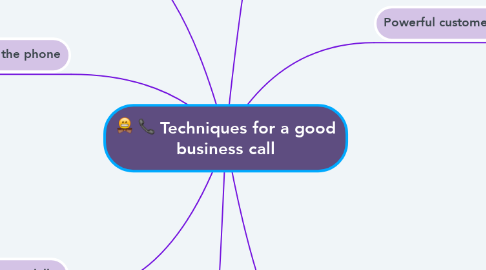
1. Communication skills.
1.1. 1.Practical communication
1.1.1. Any message that is to be conveyed within an organization must be practical.
1.2. 2.Communication based on facts
1.2.1. When it comes to running an organization, it is important to support all formal communication with the relevant facts.
1.3. 3.Persuasive communication
1.3.1. Persuasive communication can help you change how people think. You can influence others.
1.4. 4.Concise communication
1.4.1. Keep important messages short and brief.
1.5. 5.Identifying emotions
1.5.1. This will allow a better understanding between the members during a discussion.
1.6. 6.Open communication
1.6.1. Employers and employees should be able to communicate openly.
1.7. 7.Good questions
1.7.1. Ask clear and straightforward questions. Be authoritative without appearing as though you are trying to establish dominance.
2. Courtesy call
2.1. Make the courtesy call from a moderately quiet area using a company phone.
2.2. Dial the number and wait for the party to answer. Wait for the client to say, "Hello" then speak. Identify yourself and the company you represent.
2.3. Verify that you are speaking to the correct party.
2.4. Provide the service by giving or requesting the required information. Be polite and helpful during the call.
2.5. Thank the customer for his time and remind him of how he can contact you if he has further questions.
3. Smiling on the phone
3.1. “Smiling affects how we speak, to the point that listeners can actually identify the type of smile based on sound alone…” And since 84% of the message over a phone is your tone of voice, making sure that “smiling tone” comes through is imperative.
4. Clarifying information
4.1. Clarify What You Heard by Asking for Repetition.
4.2. Confirm Your Understanding By Repeating and Restating the Other Person’s Idea
4.3. Say Thank You and Show You Understood
5. Great last impression
5.1. Gather your belongings in your left hand.
5.1.1. That will keep you from fumbling to free up your right hand when the interviewer reaches out to shake it.
5.2. Make physical contact twice before leaving.
5.2.1. Physical contact promotes bonding; even a handshake has been shown to increase rapport and make you more likable and memorable.
5.3. End with eye contact and a smile.
5.3.1. You’ll leave behind the impression of someone who’s open, straightforward, and warm.
5.4. Thank the person twice.
5.4.1. As you make physical contact, look the other person in the eye, and smile, thank them for their time and or the event/evening you’ve spent together.
5.5. Make sure you have all your belongings.
5.6. Move with intent.
5.6.1. Know exactly what you’re doing next, where you’re heading, and move confidently and deliberately in that direction.
5.7. Send a follow-up text/thank you note.
5.7.1. Sending an appreciative text or thank you note is a really nice touch, and extends and solidifies the warm memory people have formed of you in their minds.
6. Powerful customer phrases
6.1. “I don’t know, but let me find out.”
6.1.1. You have to be the one who is contacting those other people and finding the answer for your customer. The point is to reduce customer effort which leads to improved customer satisfaction.
6.2. “Thank you for bringing this to our attention.”
6.2.1. The observant customer is most likely not looking for anything more than recognition of their effort. Being polite doesn’t really cost you a dime.
6.3. “I certainly can check that for you.”
6.3.1. You want to increase your customer’s confidence in your brand. Show that you’re a professional who gets things done.
6.4. “I apologize for the inconvenience.”
6.4.1. If a customer is frustrated, it’s crucial to show empathy to the customer and let them know that you understand their concerns.
6.5. “I will update you by [time].”
6.5.1. In addition to keeping the customer informed about the status of their request, it provides you the opportunity to build trust.
6.6. “Happy to help.”
6.6.1. Adding positive power to your words is the simplest way to make your customers feel more valuable.
6.7. “As much as I would love to help...”
6.7.1. This is a polite way to say no, and it’s better not to lead your customer on if you’re certain that there will be no solution.
7. Mindset for Serving Customers
7.1. Empathy
7.1.1. They want to know that you see the problem from their point of view. A caring, empathetic tone, more than words, allows the customer to hear your concern.
7.2. Enthusiasm
7.2.1. Your enthusiasm influences your effectiveness in a service position, because the appropriate enthusiasm determines how the world sees you as able or willing to help.
7.3. Ownership
7.3.1. It shouldn’t take two people to give good customer service. Step up and take ownership of the challenges that come your way.
7.4. Responsibility
7.4.1. This trait relates just as easily to your co-workers as to your customers. In every case, it’s critical that we live up to our commitments.
7.5. Adaptability
7.5.1. Is having an easy flexibility to deal effectively with different types of customers and situations.
7.6. Balance
7.6.1. Requires the capacity to be successful at satisfying the customer, while taking into account the resources and needs of your organization.
7.7. Resiliency
7.7.1. We need to be able to bounce back emotionally and professionally and handle those setbacks, while never taking out frustrations on customers or co-workers.
